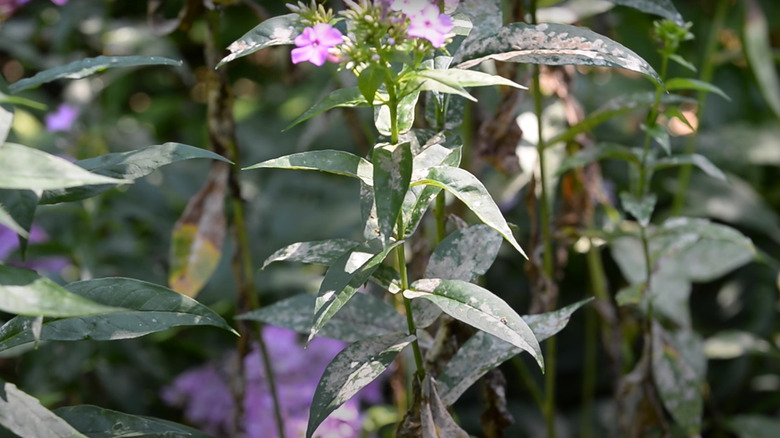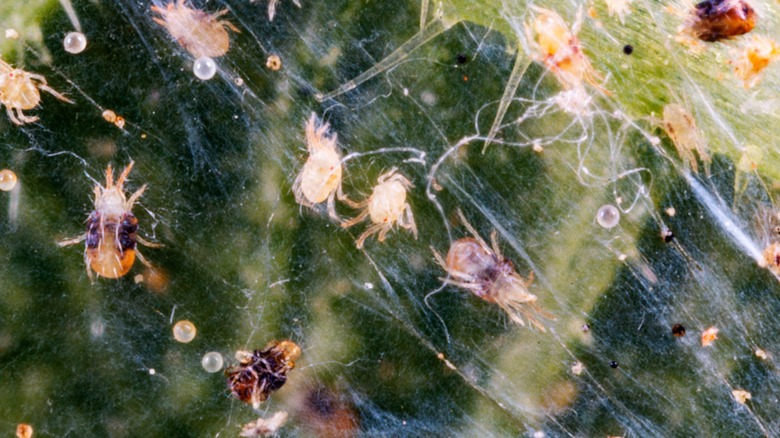Gardeners searching for the perfect flowering coverage for their tree roots will likely look at creeping phlox (Phlox stolonifera). These 1-foot tall, mat-forming understory plants exhibit star-shaped inflorescence in indigo blues, pearl whites, blush pinks, or amethyst violets that can brighten any landscape, including riparian beds and rock gardens. Even hummingbirds and butterflies find these aromatic flowers irresistible. While their myriad features make a strong case for growing creeping phlox plants, it’s undeniable that they’ve got their fair share of downsides. Fungi find their foliage quite palatable and love to afflict them with powdery mildew and black root rot disease.
As its name implies, powdery mildew — a result of a Sphaerotheca humuli or Erysiphe cichoracearum infliction — appears as grayish-white threads on the bottom leaves, eventually killing the herbaceous perennial. In contrast, Thielaviopsis basicola (black rot-causing fungi) catches phlox when they’re still young, causing dark, decaying crowns. To boot, despite successfully keeping rabbits and deer at a safe distance, phlox are abysmal at shaking off tiny pests like slugs and spider mites, especially when the soil is too wet or dry, respectively.
Foliage dies a swift death

TribLIVE / YouTube
Powdery mildew has a filthy habit of wounding all phlox cultivars, and the star rock phlox is no exception. These fungi flourish in humid conditions that are unrelated to the presence of standing water. Daytime spring temperatures exceeding 60 degrees Fahrenheit spur spore formation, which hitch an air ride to jump down on the leathery, ovate leaves. Merely three successive days of cool, humid nights accompanied by dry, hot days are sufficient to have them spreading. The spores target the lower leaves first, blanketing them in tiny, spherical, grayish-white marks. When the lower foliage is out, they hike up the higher branches, weakening the ground cover and hurting its blooms. A severe infestation eventually causes withering and browning of the perennial’s tissues, sending it to an early grave.
While you can minimize the trouble by planting the more resistant varieties, it will prove insufficient if you slack on cultural sanitation. So, ensure you prune the semi-evergreen plants during spring to enhance air circulation. Also, space the phlox per its maturity height (no shorter than 12 inches) to avoid crowding out. Ensure you don’t drench your leaves during irrigation, raising humidity. Instead, focus on soaking the phlox’s roots. If the mildew still finds a way to your precious understory, pluck out all diseased leaves. Later, deadhead the spent and damaged stems after the blooming season ends and apply a fungicide. This should also take care of any self-seeding.
Be wary of insects and root rot

Sometimes, your phlox’s leaves can discolor, turning speckled bronze, despite the summer not being humid. Chances are that spider mites are in action, so look for any small webs on the foliage’s underside. If so, treat them with insecticide soap for successful elimination. Another problem that has now set its sights on the creeping phlox growing in your yard is black root rot. Typical symptoms include leggy stems, wilted, yellowing leaves, and stunted plant growth that can pass off as any cultural mistake. For instance, you could mistake it for under-fertilization if the mature and new foliage is tinged pale yellow and crimson-green, respectively. Irregularly patterned yellow spots, instead of uniform spreading, generally indicate fungus.
When growing the bedding plants in wet, alkaline soils, keep an eye out for black rot, particularly when the temperatures fluctuate between 55 and 61 degrees Fahrenheit. An early infestation will appear as stretched, red gashes on the roots, later transforming into black, rotten spots. To keep the fungi at bay, lower the soil’s pH to under 5.6, avoid splashing and overhead irrigation, and use disinfected gardening tools. Remove the infected plants if the disease gains entry. Finally, brace yourself to handpick slugs when you don’t see your five-petaled flowers blooming — even after following the right practices to the T — in your shaded, rocky gardens.



